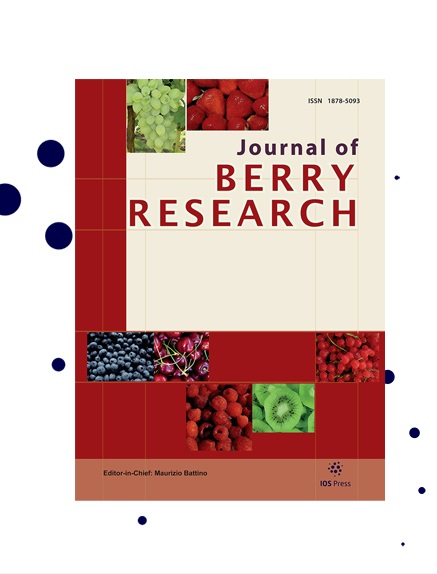The anti-tumor activity and critical active compounds of polyphenols from Chinese dwarf cherry (Cerasus humilis)
IF 1.4
4区 农林科学
Q3 PLANT SCIENCES
引用次数: 0
Abstract
BACKGROUND: Cerasus humilis (Bge.) Sok. fruit (Ouli) is rich in polyphenols and has a potential anti-tumor effect. However, its anti-tumor functional compositions and mechanism remain unclear. OBJECTIVE: This study aims to investigate the antitumor activity and chemical composition of polyphenols from Ouli, and to identify the critical antitumor substances and potential mechanisms METHODS: Polyphenols of 14 germplasms were extracted and purified; the inhibitory effects of Ouli polyphenols on the proliferation of liver cancer HepG2 cells, colon cancer HCT116 cells, and gastric cancer BGC823 cells were evaluated by MTT assay; polyphenol compounds were identified by ultra-high-performance liquid chromatography-quadrupole time-of-flight mass spectrometry; partial least squares were utilized to build chemometrics models for selecting anti-tumor compounds; the key targets and pathways of antitumor effects of Ouli were predicted by network pharmacology. RESULTS: The total polyphenol content ranged from 275.9 to 598.2 mg/100 g fresh weight, with an average of 381.2 mg/100 g FW; Ouli polyphenols has potent inhibitory effects on liver, colon, and gastric cancer cells; twenty-three polyphenols were identified; a total of 12, 17, and 18 components were anti-liver cancer, anti-colon cancer, and anti-gastric cancer active polyphenols, respectively; TP53, MAPK3, MAPK1, RELA, AKT1, PIK3R1 and other 16 genes are the key anti-tumor targets; pathway in cancer, lipid and atherosclerosis, colorectal cancer, microRNAs in caner, HIF-1 signaling pathway and other pathways are the key pathways for anti-tumor effects of Ouli. CONCLUSIONS: Ouli polyphenols can be developed as a functional natural product to intervene in liver, stomach, and colon cancers.矮樱桃多酚的抗肿瘤活性及关键活性成分
背景:矮樱桃(Cerasus humilis)目前。枸杞富含多酚类物质,具有潜在的抗肿瘤作用。然而,其抗肿瘤功能成分和机制尚不清楚。目的:研究瓯丽多酚的抗肿瘤活性和化学成分,确定其抗肿瘤的关键物质及其作用机制。方法:对14份瓯丽种质的多酚进行提取纯化;MTT法观察藿香多酚对肝癌HepG2细胞、结肠癌HCT116细胞、胃癌BGC823细胞增殖的抑制作用;采用超高效液相色谱-四极杆飞行时间质谱法鉴定多酚类化合物;利用偏最小二乘法建立抗肿瘤化合物的化学计量模型;运用网络药理学方法预测了乌力抗肿瘤作用的关键靶点和通路。结果:总多酚含量范围为275.9 ~ 598.2 mg/100 g鲜重,平均为381.2 mg/100 g FW;藿香多酚对肝癌、结肠癌、胃癌细胞有较强的抑制作用;共鉴定出23种多酚;抗肝癌活性多酚12个、抗结肠癌活性多酚17个、抗胃癌活性多酚18个;TP53、MAPK3、MAPK1、RELA、AKT1、PIK3R1等16个基因是抗肿瘤的关键靶点;癌症、脂质和动脉粥样硬化、结直肠癌、癌症中的microrna、HIF-1信号通路等途径是奥立抗肿瘤作用的关键途径。结论:藿香多酚可作为一种功能性天然产物开发用于干预肝癌、胃癌和结肠癌。
本文章由计算机程序翻译,如有差异,请以英文原文为准。
求助全文
约1分钟内获得全文
求助全文
来源期刊

Journal of Berry Research
Biochemistry, Genetics and Molecular Biology-Biochemistry
CiteScore
3.50
自引率
11.80%
发文量
21
期刊介绍:
The main objective of the Journal of Berry Research is to improve the knowledge about quality and production of berries to benefit health of the consumers and maintain profitable production using sustainable systems. The objective will be achieved by focusing on four main areas of research and development:
From genetics to variety evaluation
Nursery production systems and plant quality control
Plant physiology, biochemistry and molecular biology, as well as cultural management
Health for the consumer: components and factors affecting berries'' nutritional value
Specifically, the journal will cover berries (strawberry, raspberry, blackberry, blueberry, cranberry currants, etc.), as well as grapes and small soft fruit in general (e.g., kiwi fruit). It will publish research results covering all areas of plant breeding, including plant genetics, genomics, functional genomics, proteomics and metabolomics, plant physiology, plant pathology and plant development, as well as results dealing with the chemistry and biochemistry of bioactive compounds contained in such fruits and their possible role in human health. Contributions detailing possible pharmacological, medical or therapeutic use or dietary significance will be welcomed in addition to studies regarding biosafety issues of genetically modified plants.
 求助内容:
求助内容: 应助结果提醒方式:
应助结果提醒方式:


